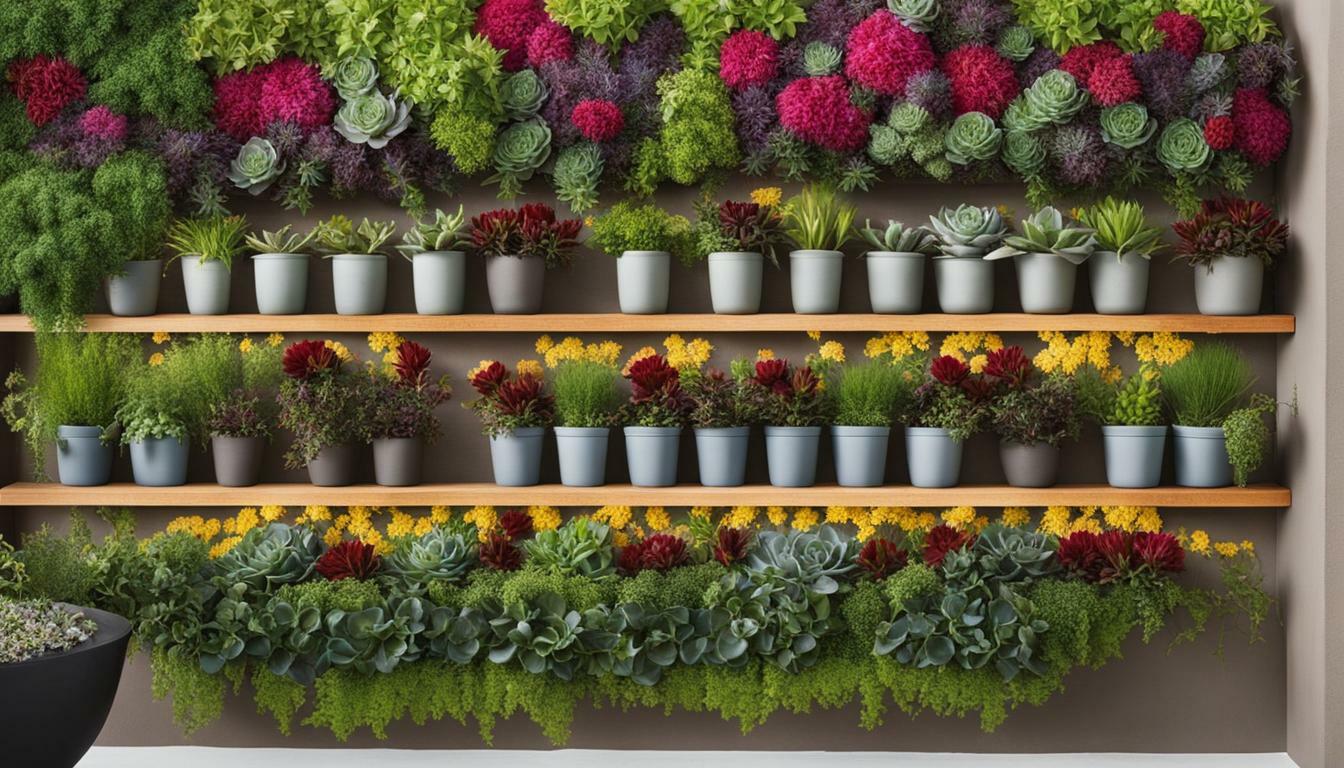Discover the transformative power of vertical garden building and how it can enhance your living or working space. Whether you have a small balcony, a limited backyard, or even a blank wall indoors, vertical gardening offers a creative and innovative solution to maximize your gardening space and bring nature into your surroundings.
Key Takeaways:
- Vertical garden building techniques allow you to utilize garden space effectively, even in small or limited areas.
- Vertical gardens provide a unique and decorative feature that can be used both indoors and outdoors.
- By incorporating stackable planters, EMT conduit, and Maker Pipe connectors, you can create a multi-purpose gardening structure that maximizes your growing space.
- Vertical gardens offer a budget-friendly solution for transforming your space and adding a touch of greenery.
The Benefits of Vertical Gardening
Vertical gardening offers numerous benefits, from maximizing space to improving air quality and aesthetic appeal. Whether you have a small balcony, a limited backyard, or even just a blank wall, vertical gardening techniques allow you to transform these areas into thriving green spaces. Let’s explore some of the key advantages of vertical gardening:
1. Space Optimization:
One of the major benefits of vertical gardening is its ability to make the most of limited space. By utilizing vertical structures such as walls, fences, or trellises, you can create a lush garden without taking up valuable floor space. This is particularly beneficial for urban dwellers or those with small outdoor areas.
2. Improved Air Quality:
Vertical gardens act as natural air purifiers, helping to improve the air quality around your home. Plants absorb carbon dioxide and release oxygen through the process of photosynthesis, reducing pollutants and creating a healthier environment. This can have a positive impact on your well-being, especially if you live in an urban area with high levels of air pollution.
3. Aesthetically Pleasing:
Vertical gardens add a touch of beauty and visual interest to any space. They can serve as living artwork, adding color, texture, and a sense of tranquility to your surroundings. Whether you opt for a uniform arrangement of plants or a mixture of different species, vertical gardens can be customized to suit your personal style and enhance the overall aesthetics of your space.
4. Increased Plant Varieties:
Vertical gardening allows you to grow a wider variety of plants, including those that may not thrive in traditional garden beds. Different plants have varying light and moisture requirements, and vertical gardens offer the flexibility to create microclimates that meet these needs. You can experiment with a diverse range of flowers, herbs, vegetables, and even succulents, expanding your gardening possibilities.
These are just a few of the many benefits that vertical gardening can offer. Whether you’re looking to maximize space, improve air quality, enhance visual appeal, or expand your plant collection, vertical gardening techniques provide sustainable and nature-inspired solutions for transforming your space.
| Advantages | Benefits |
|---|---|
| Space optimization | Maximizing limited space, especially in urban areas or small outdoor spaces. |
| Improved air quality | Natural air purifiers, reducing pollutants and improving overall air quality. |
| Aesthetically pleasing | Adding beauty, color, and visual interest to any space. |
| Increased plant varieties | Ability to grow a wider variety of plants with different light and moisture requirements. |
Creative Vertical Garden Designs
Get inspired by these creative vertical garden designs that can add a unique touch to your space. Whether you have a small balcony, limited backyard, or just want to bring some greenery indoors, these designs offer innovative solutions for vertical gardening. From hanging wall planters to DIY pallet planters, there are endless possibilities to explore.
Hanging Wall Planters
One popular option for vertical gardens is hanging wall planters. These planters can be easily attached to any bright window in your kitchen or living space. Not only do they provide an aesthetic appeal, but they also allow you to have fresh herbs at your fingertips while cooking. You can create a beautiful display by choosing a variety of herbs and arranging them in the planters.
Table: Hanging Wall Planters
| Plant Selection: | Description: |
|---|---|
| Basil | A popular herb for culinary use and adds a fresh aroma to the kitchen. |
| Mint | Great for adding flavor to teas and cocktails. |
| Parsley | Commonly used as a garnish and adds a fresh taste to dishes. |
DIY Pallet Planters
If you’re looking for a budget-friendly and eco-friendly option, DIY pallet planters are a great choice. You can easily transform old wooden pallets into stunning vertical gardens. Simply attach landscape fabric to the back of the pallet and fill each opening with soil and plants. This creative design not only saves space but also adds a rustic charm to your outdoor or indoor space.
“Creating a vertical garden can be a great way to create more space while showcasing your plants in a new and artful way.” – Luke Dejahang, CEO of Crown Pavillions
Tin Can Fence Garden
For a fun and affordable option, consider creating a tin can fence garden. This DIY project involves spray-painting tin cans and attaching them to a fence. You can plant a variety of flowers, herbs, or succulents in each can, creating a colorful and vibrant display. It’s a great way to recycle and add a touch of whimsy to your outdoor space.
| Flower Selection: | Description: |
|---|---|
| Petunias | Perfect for adding bright color and blooms to your vertical garden. |
| Ivy | A versatile vine that adds a lush greenery to any space. |
| Succulents | Drought-tolerant plants that require minimal maintenance. |
With these creative vertical garden designs, you can transform your space into a green oasis. Whether you choose hanging wall planters, DIY pallet planters, or a tin can fence garden, the possibilities are endless. Let your imagination soar and create a unique and beautiful vertical garden that suits your style and space.
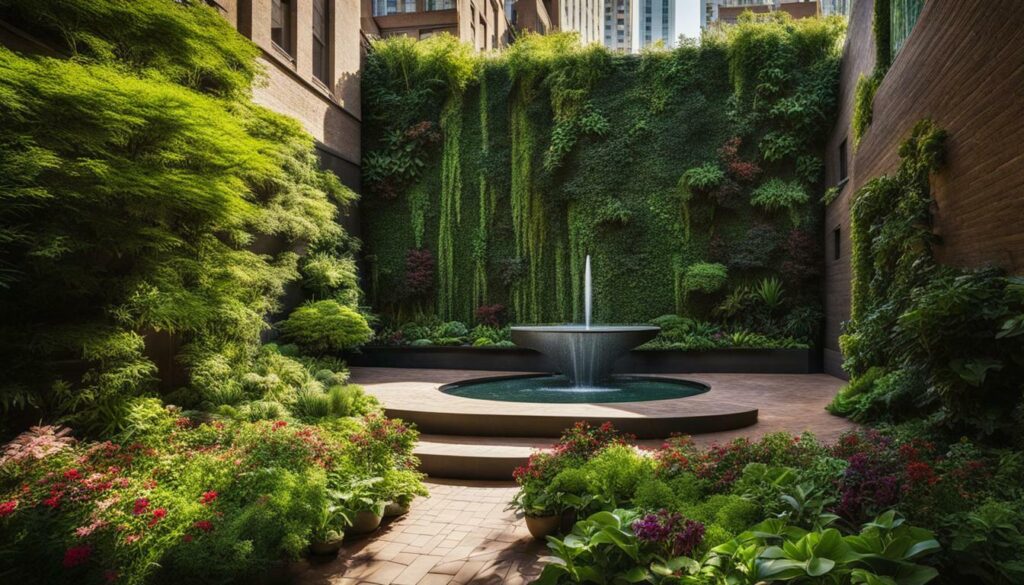
Materials and Tools for Vertical Garden Building
Learn about the essential materials and tools required for successful vertical garden building. Creating a vertical garden is an innovative way to transform your space and maximize your gardening area, whether you have a small balcony or a sprawling backyard. By utilizing the vertical space, you can create a stunning garden that not only adds beauty but also provides numerous benefits.
When it comes to materials, there are a few key components you’ll need. Firstly, sturdy and durable containers or planters are essential for holding the soil and plants in place. These can be made of various materials such as plastic, ceramic, or metal, depending on your aesthetic preferences and budget. Additionally, you’ll need a reliable support structure to hold the containers vertically, such as trellises, frames, or hanging systems.
To ensure proper drainage and prevent water accumulation, it’s important to have adequate drainage materials, such as gravel or rocks, at the bottom of each container. This allows excess water to flow out freely, preventing root rot and ensuring the health of your plants. Lastly, you’ll need high-quality potting soil or a well-balanced gardening mix that provides essential nutrients and supports healthy plant growth.
Now let’s move on to the tools you’ll need for vertical garden building. Basic gardening tools such as a trowel, pruning shears, and gloves are essential for planting and maintaining your vertical garden. Depending on the complexity of your design, you may also require additional tools such as a drill, screws, or wire cutters to assemble the support structures.
Table: Essential Materials and Tools for Vertical Garden Building
| Materials | Tools |
|---|---|
| Containers or planters (plastic, ceramic, metal) | Trowel |
| Support structures (trellises, frames, hanging systems) | Pruning shears |
| Drainage materials (gravel, rocks) | Gloves |
| Potting soil or gardening mix | Drill (if necessary) |
| Screws (if necessary) | |
| Wire cutters (if necessary) |
With these essential materials and tools, you’ll be well-equipped to embark on your vertical garden building project. Remember to choose high-quality materials and invest in reliable tools to ensure the longevity and success of your vertical garden. By following proper techniques and using the right materials, you can transform your space into a stunning vertical garden that brings nature closer to you.
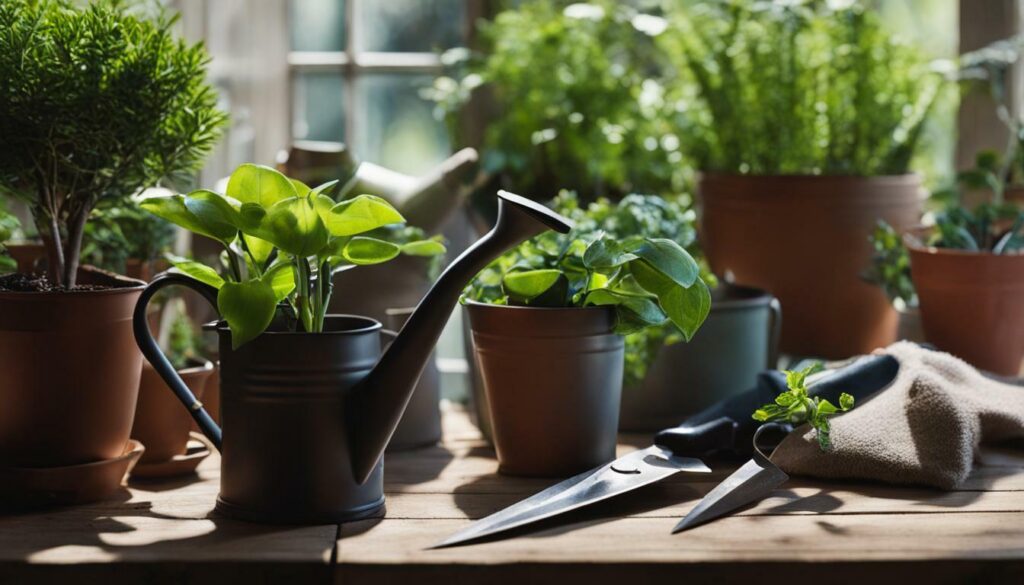
DIY Vertical Garden Building Techniques
Discover step-by-step DIY techniques for building your own vertical garden and unleash your creativity. Vertical gardening is a versatile and space-saving way to bring greenery into your home or outdoor area. With the right tools and materials, you can create a stunning vertical garden that adds beauty and functionality to any space.
One popular DIY technique for vertical gardening is using stackable planters and Electrical Metallic Tube (EMT) Conduit. This method, as shared by Aaron from the Maker Pipe community, involves sliding stackable planters over vertical pieces of EMT Conduit to create a multi-purpose gardening structure. It’s a cost-effective solution that maximizes gardening space, making it perfect for small gardens or urban areas.
To create your own vertical garden using this technique, you’ll need stackable planters, EMT Conduit, and Maker Pipe Connectors. Start by cutting a star-shaped hole in the center of each planter to allow them to slide easily over the EMT conduit. Then, slide the planters onto the vertical pieces of EMT Conduit, stacking them as desired. Finally, fill the planters with your favorite plants and enjoy your vertical garden masterpiece.
Table: Materials for DIY Vertical Garden Building
| Materials | Tools |
|---|---|
| Stackable planters | Utility knife |
| EMT Conduit | N/A |
| Maker Pipe Connectors | N/A |
With these DIY techniques, you can transform any space into a lush vertical garden. Whether you have a small balcony, a patio, or even an indoor area, vertical gardening offers endless possibilities for creating a green oasis. So roll up your sleeves, gather your materials, and get ready to build your own vertical garden that will impress and inspire.
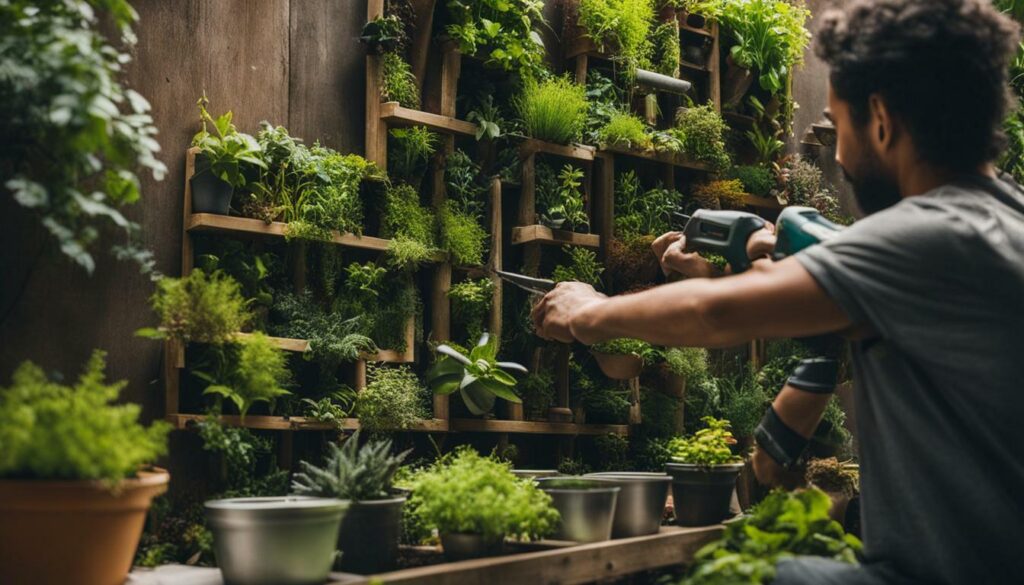
“Vertical gardening is an innovative and space-saving solution for bringing nature indoors. By using simple DIY techniques, you can transform any space into a thriving vertical garden. It’s a creative way to add beauty and functionality to your surroundings.”
Maximizing Vertical Space
- Stackable planters and EMT Conduit allow for vertical gardening in small spaces.
- The multi-purpose gardening structure provides shade, support for climbing plants, and a dedicated area for vertical gardening.
- By utilizing the height of a space, you can maximize your gardening area and create a stunning visual display.
By following these DIY vertical garden building techniques, you can create a beautiful and functional green space that will transform your surroundings. Whether you’re a beginner or an experienced gardener, vertical gardening opens up a world of possibilities for bringing nature into your home or outdoor area. So grab your tools, get creative, and start building your own vertical garden today!
Vertical Garden Maintenance and Care
Learn how to properly maintain and care for your vertical garden to ensure its long-term success. Vertical gardens require regular attention and care to thrive and remain healthy. By following these maintenance tips, you can enjoy a beautiful and flourishing vertical garden in your space.
1. Watering: Adequate watering is crucial for the health of your vertical garden. Make sure to water your plants regularly, especially during hot and dry periods. Pay attention to the specific water needs of each plant and adjust your watering schedule accordingly.
2. Fertilizing: Provide your vertical garden with the nutrients it needs to thrive by regularly fertilizing the plants. Choose a high-quality, slow-release fertilizer suitable for the types of plants in your vertical garden. Follow the instructions on the fertilizer packaging for the correct application method and frequency.
3. Pruning and Trimming: Regular pruning and trimming are essential for maintaining the shape and health of your vertical garden. Remove any dead or damaged leaves, stems, or flowers to promote new growth and prevent the spread of diseases or pests. Trim back overgrown plants to maintain a neat and well-maintained appearance.
4. Pest and Disease Control: Keep a close eye on your vertical garden for signs of pests or diseases. Common issues in vertical gardens include aphids, spider mites, and powdery mildew. If you notice any problems, take immediate action to prevent further damage. Use organic pest control methods or consult a professional if necessary.
| Vertical Garden Maintenance Tips | Care Tips |
|---|---|
| Regularly water your vertical garden. | Choose a high-quality, slow-release fertilizer. |
| Prune and trim plants as needed. | Monitor for pests and diseases. |
| Remove dead or damaged foliage. | Provide adequate sunlight and ventilation. |
Quote: “Vertical gardens require regular attention and care to thrive and remain healthy.” – Vertical Garden Specialist
By following these maintenance and care tips, you can create a thriving vertical garden that adds beauty and greenery to your space. Remember to provide adequate sunlight and ventilation to your plants and monitor their growth regularly. With proper maintenance, your vertical garden will continue to flourish and provide a stunning and sustainable nature-inspired solution for your space.
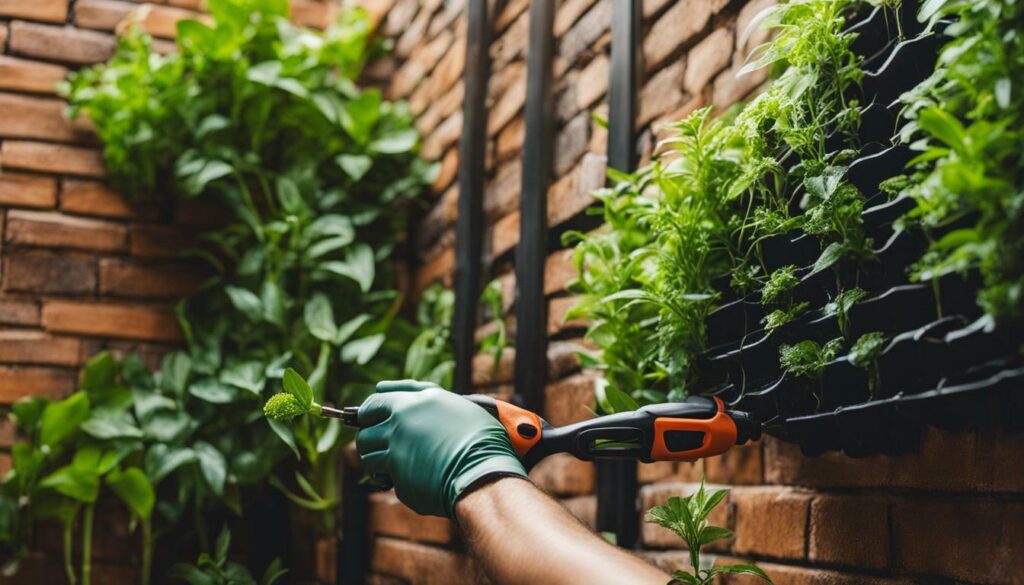
Additional Resources:
- The Ultimate Guide to Vertical Garden Maintenance
- Tips for Preventing Common Vertical Garden Problems
- Expert Advice on Vertical Garden Care and Maintenance
Choosing the Right Plants for Vertical Gardens
Explore the wide range of plant options and discover how to choose the right ones for your vertical garden. Vertical gardens offer a unique and visually stunning way to bring greenery into any space, and selecting the right plants is crucial for their success.
Consider Light and Shade Requirements
When choosing plants for your vertical garden, it’s important to consider their light and shade requirements. Some plants thrive in full sunlight, while others prefer shady conditions. Assess the amount of sunlight your vertical garden receives throughout the day and select plants accordingly. For example, sun-loving plants like succulents and herbs are great choices for areas with ample sunlight, while ferns and ivy are better suited for shaded spaces.
Choose Plants with Compatible Growth Habits
Consider the growth habits of different plants when selecting for your vertical garden. Some plants, like climbers and vines, are natural choices for vertical gardening as they can easily attach themselves to support structures and flourish in tight spaces. Other options include cascading plants that hang down from higher levels, providing a beautiful cascading effect. Mixing plants with different growth habits can create a visually dynamic and diverse vertical garden.
Select Plants with Suitable Root Systems
Since vertical gardens typically have limited soil space, it’s essential to choose plants with suitable root systems. Look for plants with shallow root systems that can thrive in smaller containers or pouches. Additionally, consider the water requirements of different plants when making your selection. Drought-tolerant plants are often better suited for vertical gardens as they can withstand periods of limited watering better than plants with higher water needs.
| Plant Type | Light Requirements | Growth Habit | Root System |
|---|---|---|---|
| Succulents | Full Sun | Cascading or Compact | Shallow |
| Herbs | Full Sun | Upright or Cascading | Shallow |
| Ferns | Shade or Partial Sun | Cascading | Shallow |
| Ivy | Shade or Partial Sun | Climbing or Cascading | Shallow |
By considering the light and shade requirements, growth habits, and root systems of different plants, you can create a vibrant and thriving vertical garden that adds beauty and life to any space.
Note: The provided table offers a few examples of plant types and their characteristics, but there are countless options available for vertical gardens. Research specific plants that fit your climate and preferences for a successful vertical garden.
Vertical Gardens for Small Spaces
Find out how vertical gardens can transform even the tiniest of spaces into thriving green areas. With limited horizontal gardening space, many home gardeners and urban dwellers face the challenge of finding creative solutions to grow plants. Vertical gardening is a popular technique that maximizes space by utilizing walls, fences, and other vertical surfaces to create functional and aesthetically pleasing gardens.
One innovative DIY vertical gardening solution involves using Electrical Metallic Tube (EMT) Conduit, Maker Pipe Connectors, and stackable planters. This method, shared by Aaron from the Maker Pipe community, allows for the creation of a multi-purpose gardening structure that is perfect for small-space gardening. The structure not only serves as a decorative feature but also provides a shaded sitting area, protection for raised garden beds, supports for climbing plants, and a dedicated space for vertical gardening.
To create your own vertical garden, you will need stackable planters, EMT Conduit, and Maker Pipe Connectors. Start by selecting stackable planters of various sizes and cutting star-shaped holes in the center of each planter to allow them to slide over the EMT conduit easily. Then, slide the planters over the vertical pieces of EMT Conduit, stacking them to your desired height and gardening needs. Once the structure is set up, you can start planting and enjoy the benefits of a vertical garden in a small space.
| Benefits of Vertical Gardens for Small Spaces: |
|---|
| Maximizes limited gardening space |
| Adds a decorative feature to outdoor and indoor areas |
| Provides shaded sitting areas |
| Offers protection for raised garden beds |
| Supports climbing plants |
With vertical gardens, even the smallest of spaces can be transformed into lush, green areas that bring nature closer to you.
Vertical Gardens in Urban Environments
Discover how vertical gardens are making a positive impact in urban environments, creating pockets of green amidst the concrete jungle. As cities become more densely populated, finding space for traditional gardens can be a challenge. Vertical gardens offer a solution by utilizing vertical space, such as walls, fences, and balconies, to create stunning and sustainable green spaces.
One innovative DIY gardening solution for urban environments involves utilizing electrical metallic tube (EMT) conduit, stackable planters, and Maker Pipe connectors. This method allows for the creation of a multi-purpose gardening structure that not only maximizes space but also serves as a decorative feature. The structure can provide a shaded sitting area, protection for raised garden beds, supports for climbing plants, and a dedicated area for vertical gardening.
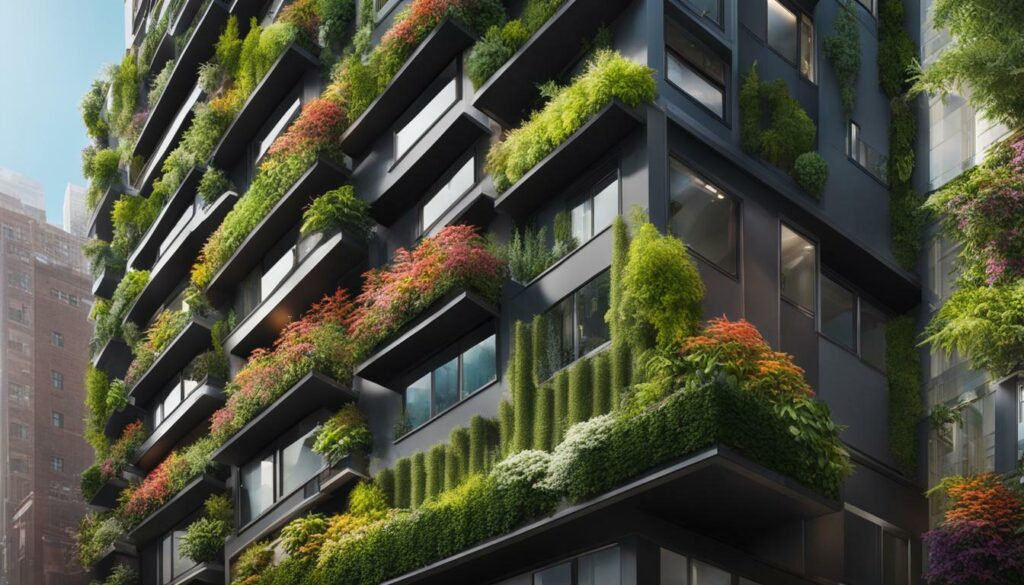
To create your own vertical garden, you will need stackable planters, EMT conduit, and Maker Pipe connectors. Start by cutting a star-shaped hole in the center of each planter using a utility knife. This will allow the planters to slide over the EMT conduit easily. Next, slide the planters over the vertical pieces of EMT conduit in your project, stacking them to your desired height. Once the structure is set up, you can begin planting, taking advantage of the planters’ drainage holes to avoid water accumulation.
| Benefits of Vertical Gardens in Urban Environments |
|---|
| Maximizes limited space |
| Improves air quality |
| Reduces urban heat island effect |
| Creates a sense of well-being |
| Enhances aesthetic appeal |
Quote: “Vertical gardens can transform concrete jungles into vibrant green spaces, providing numerous benefits for urban dwellers and the environment.” – [Gardening Expert]
Urban Vertical Garden Projects
Urban vertical gardens can be implemented in various ways, from installing living walls in public spaces to creating private green sanctuaries on balconies. Here are a few examples of successful urban vertical garden projects:
- Vertical garden installations in city parks and plazas
- Community-led vertical garden projects in urban neighborhoods
- Vertical gardens on the exteriors of buildings and facades
- Green roofs and rooftop gardens in urban areas
By incorporating vertical gardens into urban environments, cities can experience the numerous benefits of green spaces, including improved air quality, reduced noise pollution, and a more visually appealing landscape. Vertical gardens provide a natural escape from the urban hustle and bustle, offering a breath of fresh air and a touch of tranquility.
| Challenges of Urban Vertical Gardens |
|---|
| Limited space for large-scale installations |
| Maintenance and irrigation requirements |
| Structural considerations for supporting the weight of vertical gardens |
| Sourcing appropriate plant species for urban conditions |
In conclusion, vertical gardens are revolutionizing the way we incorporate green spaces into urban environments. Through innovative techniques and designs, cities can transform their concrete landscapes into thriving, nature-inspired havens. By embracing vertical gardening, urban dwellers can enjoy the numerous benefits of greenery, fostering a healthier, more sustainable future.
Vertical Gardens for Sustainable Living
Learn how vertical gardens support sustainable living by promoting biodiversity, reducing energy consumption, and improving air quality.
Vertical gardens, also known as living walls or green walls, are not only a beautiful addition to any space but also contribute to sustainable living practices. By utilizing vertical space to grow plants, vertical gardens offer numerous environmental benefits that make them an ideal choice for those looking to live more sustainably.
One of the key advantages of vertical gardens is their ability to promote biodiversity. These gardens provide a habitat for a variety of plant species, which in turn attracts insects and birds, supporting local ecosystems. With the loss of natural habitats due to urbanization, vertical gardens offer a way to create green spaces that help maintain biodiversity in urban environments.
In addition, vertical gardens can help reduce energy consumption. By covering vertical surfaces with plants, they act as a natural insulator, reducing heat absorption and cooling the surrounding area. This can lead to energy savings by reducing the need for air conditioning and lowering indoor temperatures.
“Vertical gardens act as a natural insulator, reducing heat absorption and cooling the surrounding area.”
Furthermore, vertical gardens improve air quality by filtering pollutants and releasing oxygen. Plants have the ability to absorb harmful substances, such as carbon dioxide and volatile organic compounds (VOCs), and release oxygen through photosynthesis. By incorporating vertical gardens into indoor and outdoor spaces, air quality can be enhanced, creating a healthier environment for occupants.
Vertical Garden Implementation Tips:
- Choose a variety of plant species to maximize biodiversity.
- Consider the orientation of the vertical garden to optimize sunlight exposure.
- Use sustainable materials, such as recycled containers or eco-friendly growing mediums.
- Implement an irrigation system that minimizes water waste.
By embracing vertical gardens, individuals can transform their spaces into sustainable, nature-inspired solutions that benefit both the environment and their well-being.
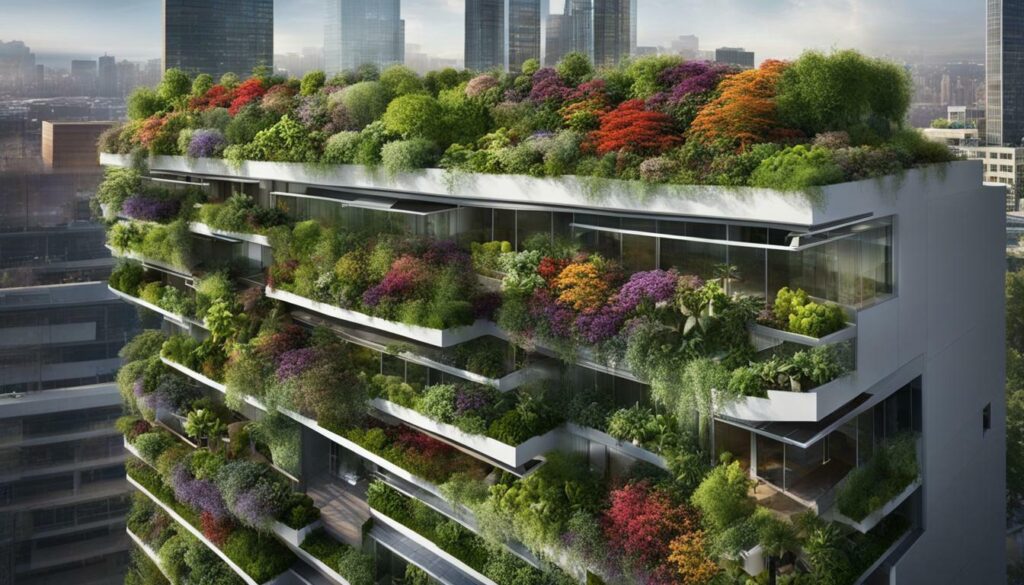
Conclusion
Vertical garden building is not only a practical solution for maximizing space but also a sustainable and nature-inspired way to transform your living or working environment. Whether you’re a home gardener with limited horizontal space or an urban dweller looking to bring greenery into your small balcony, vertical gardens offer a range of benefits that make them worth considering.
By utilizing vertical gardening techniques, you can create a multi-purpose structure that serves as both a decorative feature and a functional gardening space. This innovative approach allows you to grow plants in stackable planters, using materials like Electrical Metallic Tube (EMT) Conduit and Maker Pipe Connectors. The possibilities are endless, as you can customize the design to fit your space and gardening needs.
Vertical gardens not only add aesthetic value to your surroundings but also provide numerous benefits. They improve air quality, reduce noise pollution, mitigate heat island effects, and even boost your mental well-being. By incorporating the right plants, you can create a green oasis that promotes relaxation, productivity, and a deeper connection with nature.
Furthermore, vertical gardens offer sustainability advantages by making efficient use of space and resources. They allow you to grow your own food, reducing the need for transportation and packaging. Additionally, vertical gardens can be designed with irrigation systems that optimize water usage, minimizing waste and promoting eco-friendly gardening practices.
In conclusion, vertical garden building is a nature-inspired solution that enables you to transform your space sustainably. Whether you’re looking to beautify your home, enhance your outdoor areas, or create green spaces in urban environments, vertical gardens offer a versatile and innovative approach. Embrace the possibilities of vertical gardening and enjoy the transformative power of nature in your everyday surroundings.
Can Modern Vertical Garden Techniques be used in Traditional Gardens as well?
Yes, modern vertical garden techniques can definitely be used in traditional gardens. The modern vertical garden revolution has brought innovative ideas like using vertical space, hydroponic systems, and modular planting to make traditional gardens more efficient and visually appealing. It’s a great way to maximize space and create a stunning garden.
FAQ
Q: What are the benefits of vertical gardening?
A: Vertical gardening maximizes space, allows for efficient use of resources, provides a decorative feature, and creates a healthier environment.
Q: What materials and tools are needed for vertical garden building?
A: The materials typically used for vertical garden building include stackable planters, EMT conduit, and Maker Pipe connectors. The necessary tools may include a utility knife and a drill.
Q: Can vertical gardens be created in small spaces?
A: Yes, vertical gardens are ideal for small spaces as they utilize wall space and require minimal floor space.
Q: How do you maintain and care for a vertical garden?
A: Vertical gardens require regular watering, fertilizing, and pruning. It is important to monitor the moisture levels and ensure proper drainage to prevent water accumulation.
Q: What are the best plants for vertical gardens?
A: The selection of plants for vertical gardens depends on factors such as sunlight exposure and personal preference. Some popular choices include herbs, succulents, and flowering vines.
Q: Can vertical gardens be created in urban environments?
A: Yes, vertical gardens are particularly suited for urban environments where space is limited. They can be installed on balconies, rooftops, and even in indoor spaces.
Q: How do vertical gardens contribute to sustainable living?
A: Vertical gardens promote sustainable living by enhancing air quality, reducing energy consumption, and providing a habitat for beneficial insects and wildlife.

